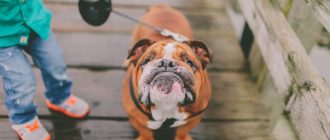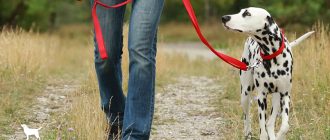Is my dog more aggressive on leash than he is on the loose? Why is he so reactive to leash walks? How do I stop the problem? There are several reasons your dog may be leash reactive. Listed below are the most common ones. Identifying the underlying causes will help you stop leash aggression and prevent it from getting worse. In some cases, your dog may be reacting to stress. This may be causing your dog to lunge at other dogs, bark, or even kick you.
Why is my dog more aggressive on leash?
If you’ve ever wondered why your dog becomes more aggressive when on a leash, you’re not alone. Dogs who are more aggressive on a leash are often fearful of other dogs. This is partly because they are unable to get away from an unknown threat when they’re off-leash. In addition, leash-aggressive dogs are prone to displaying aggressive behavior when their owners leave them alone.
Leash reactivity is caused by several factors, the most common of which are fear and frustration. When a dog becomes leash aggressive, it can make a dog’s owner feel embarrassed and overwhelmed. If you’re unsure of the cause, first try implementing management measures. First, give the dog enough space to feel comfortable, and then introduce games that distract your dog. High-value treats or engaging in an “engage-disengage” game can help your dog overcome his fear and frustration.
Why is my dog aggressive when I walk him?

A new behavior that is frustrating for both you and your dog can start as a simple attack. It can develop into a serious problem as it begins to escalate in frequency and intensity. If you’re unsure why your dog is attacking people and other dogs, call your vet for further evaluation. They will be able to diagnose the problem and prescribe a course of treatment to help your dog overcome his aggression. Read on to learn some tips for handling your dog’s aggression:
Top-10 Dog Leashes
| Image | Price | Buy | Prime | Title |
|---|---|---|---|---|
 Top Top | Buy on Amazon | PrimeEligible | TUG 360° Tangle-Free Retractable Dog Leash | 16 ft Strong Nylon Tape | One-Handed Brake, Pause, Lock (Medium, White) | |
 Top Top | Buy on Amazon | PrimeEligible | BAAPET 2/4/5/6 FT Dog Leash with Comfortable Padded Handle and Highly Reflective Threads for Small Medium and Large Dogs (5FT-1/2'', Black) | |
 Top Top | Buy on Amazon | PrimeEligible | Fida Retractable Dog Leash, 16 ft Dog Walking Leash for Small Dogs up to 26 lbs, 360° Tangle Free, Black | |
 Top Top | Buy on Amazon | PrimeEligible | iYoShop Hands Free Dog Leash with Zipper Pouch, Dual Padded Handles and Durable Bungee for Walking, Jogging and Running Your Dog (Large, 25-120 lbs, Black) | |
 Top Top | Buy on Amazon | PrimeEligible | Mighty Paw Retractable Dog Leash 2.0 | 16' Heavy Duty Reflective Nylon Tape Lead for Pets up to 110lbs. Tangle Free Design W/One Touch Quick-Lock Braking System & Anti-Slip Handle (Green/Lite) |
As an Amazon Associate we earn from qualifying purchases.
While most dogs are naturally social and avoid physical confrontations, some may display aggression when out and about on leash. They use their body language to express their intent to interact, while others may simply avoid the confrontation. Unfortunately, not all dogs are good communicators, and this is one reason why some dogs are aggressive towards other dogs. Aggression between dogs can result from a lack of communication, fear, territorial behavior, and possessiveness over resources. It can be frightening for other dogs, and can even cause damage to humans trying to separate the two dogs.
How do I fix my dogs leash aggression?
Leash aggression is a problem your dog may be experiencing. Your dog may lunge at another dog, bark at it, or pull towards it. This condition is known as leash reactivity, and it can make it difficult to enjoy your dog. It is important to find a way to solve the problem before it destroys your relationship with your dog. Here are some tips for fixing leash aggression:
Understand the reason behind your dog’s aggression. Many dogs who are prone to leash aggression have a lack of social skills, and they are frustrated when restrained. Their fear often makes them lose control, so punishing them for their behavior is counterproductive and unfair. Moreover, corrections do not help your dog learn how to cope with the situation, and can even make it worse. Instead, you should try focusing on rewarding your dog’s positive behavior and encouraging his interaction with other dogs.
Why is my dog’s leash reactivity getting worse?
Leash reactivity is a common problem among dogs today. It can take many forms, including barking and lunging at other dogs, people, cars and bikes. It is different than aggressive behavior, as many dogs that show leash reactivity are friendly off the leash. Undersocialized dogs can be prone to leash reactivity, and dogs that have had negative experiences with other dogs may also be prone to the problem.
Most reactivity is caused by fear or anxiety, and it can be treated through counter conditioning or systematic desensitization. In these methods, you introduce your dog to certain triggers in small amounts, and then teach it to associate the trigger with something positive. This approach will eventually help your dog become less reactive and accustomed to its new environment. Ultimately, your dog will learn that walking on a leash is a good thing, and you’ll be happy for having made the effort.
Why is my dog reactive on leash but not off?
When dogs are on leash, they are likely to react to something. For example, they may bark or growl when they are triggered by a stranger or another dog. Other dogs react to the same stimulus and freeze, while others may growl or lunge to scare them away. These dogs are often sensitive and frustrated, and may be acting out to protect themselves from the stimulus. There are several causes of leash reactivity, and they all need to be understood before you can address the problem.
Training your dog is key to fixing this problem. Using positive reinforcement is one of the best ways to train a dog that is reactive on leash. By exposing your dog to the trigger in low doses, you can teach him to associate the trigger with a treat. The reward is a treat, and this association is a strong motivator. However, leash reactivity can be challenging, and it can take time. If you are unsure of how to train your dog to stay calm in these situations, consider enrolling in a tackling reactivity online class. The course provides a step-by-step plan for training your dog to behave in a variety of situations.

What Are the Symptoms of a Dog That is Aggressive on the Leash?
What are the symptoms of a dog that is aggressive on the leash? How do I stop my dog from attacking while walking? What are the best ways to correct the problem? There are many reasons why your dog may be acting aggressively on the leash. Here are some of them. The dog may be excited to see other dogs, bark loudly, and wag its tail. All of these can indicate a dog that is aggressive on the leash.
Can leash aggression be fixed?
Dogs with leash aggression are often frustrated because they cannot approach other dogs when they are off-leash. They perceive the other dog as a threat and therefore feel compelled to attack. In nature, dogs would turn their bodies away and avoid eye contact, preventing them from learning anything about the other dog. They may also associate the object with pain. By correcting this behavior, you can avoid a dog from attacking another animal.
There are several causes of on-leash aggression and many different remedies. Some require proactive measures that reduce the likelihood of future aggression. Other causes respond well to interventions during the moment of potential aggression. But, no matter which type of leash aggression you are dealing with, patience is key. You should not force your dog into an argument if he is not ready. Instead, wait for his signal to calm down. Even though you may feel frustrated, keep your cool and focus on the cause of the problem.
How do you address a leash aggression?
To solve the problem of leash aggression, you must first recognize what triggers this behavior. While the urge to pull a leash can be frustrating for both you and your dog, chastising or punishing your dog for this behavior will only make the situation worse. Instead, identify the trigger and use counter-conditioning and desensitization techniques to minimize your dog’s reaction to it. You can also use this method to gain your dog’s attention and train them to do something new.
Fear-driven leash aggression is often directed towards humans or other dogs. It starts with curiosity but evolves into aggression when it is forced to wait for its turn. Fast-moving objects may also trigger this reaction. A dog that has never been exposed to such objects can start out with curiosity and change to aggressive behavior if it is stopped by a human. It may even experience pain when reaching the object and thus begin associating it with pain.
How do I stop my dog from attacking while walking?
When you are walking your dog, be prepared for your dog to attack. Most attacks occur during dog-to-dog greetings. A dog with a high prey drive will attack a smaller dog. This behavior can be prevented if you know the right way to handle an attack. However, if you are not familiar with the best way to handle an attack, here are some suggestions:
– Protect yourself by placing an object between you and your dog. You can use an object to distract the dog and get to safety. A bicycle or sturdy umbrella can be used as a shield. Another way to protect yourself is to carry pepper spray or a pepper spray. These are useful tools to stop your dog from attacking you while walking. You should also report the incident to the local council if the owner is present.
What are signs of aggression in dogs?
Aggressive behavior can be difficult to identify in a dog, especially one that is well-socialized. Some dogs can easily hide injury and vulnerability, even when they are not injured. This type of behavior can be a sign of underlying illness or injury. A veterinarian can help you identify signs of aggression by performing a full physical examination and recommending standard diagnostic tests, such as a biochemistry profile, complete blood count, and urinalysis. In addition, a veterinarian may suggest a thyroid hormone test if you notice a persistent aggression problem. If your dog exhibits a consistent pattern of aggression, then the problem is likely a hormonal imbalance, and this can lead to further problems.
Another sign of aggression is leash reactivity. If your dog barks when it sees another dog, it is likely experiencing a fear response. This fear response often occurs when your dog sees another dog or person, and is often a consequence of frustration or excitement. Since dogs are naturally curious, barking on a leash can become aggressive when your dog perceives the same object as a threat. A common training method for leash aggression is to TOSS treats to passersby, who may be happy to see you.
How do I train my dog to be calm in public?
When walking your dog, avoid turning around if it is showing signs of aggression. Instead, walk slowly and in a soft, calm voice. Often, it will not respond to your aggressive body language, so it is best to remain in the peripheral vision. If your dog does show signs of aggression, try throwing a high-value treat to it. This will give you enough time to leave the area without provoking it.
Once your dog learns this command, slowly add distractions. As you continue, gradually increase the duration of the command and the amount of distractions. Once your dog responds to your command, he will be less likely to react to other people and situations. If the distractions are only minor, such as children playing, try increasing the distance. Eventually, you will notice that he or she is responding well even to the most minor distractions.













